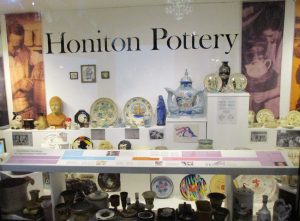
Pottery was made in Honiton for more than 240 years. Originally the pottery manufactured here was a coarse type of earthenware. Honiton pottery was started at the site in the High Street by Mr James Webber in 1881. The clay he used was dug from the ground behind the pottery.
When Mr Webber retired, Ellis Forster and William Hunt continued the business. Then they sold it to Charles Collard in 1918, who with his daughter and partner Joan exported Honiton pottery world-wide. Production stopped because of WW2 and the pottery was re-opened in 1945. Charles Collard retired two years later and sold the pottery to Chapplow and Hull who introduced electric kilns started to modernise the process and used bought-in white clay.
From 1961 until 1995 Paul Redvers was the managing director. He was a talented artist who designed ranges of pottery following the latest fashions. He introduced the Ram press to the UK which was welcomed by Wedgewood and Royal Dolton. Honiton Pottery was known for its high quality hand painting and their variety of design skills and was sold in Harrods, Next and exported around the world.

Long before dinosaurs roamed our area, it was covered by the sea. Most of the fossils on display were discovered when the Honiton by-pass was constructed in the 1960s. They show that about 140,000 years ago, Honiton was the home of large deer, oxen, elephant and hippopotamus and that we had the same sort of climate then that we associate with Africa today.

Honiton was under the jurisdiction of a Portreeve until it became a Borough in 1847. One display shows numerous objects decorated with the town seal. The origin of the figures featured is lost in time, but the most likely interpretation of the scene is that it represents the Annunciation and that the figures are the Angel Gabriel and the Virgin Mary, with the hand of God bestowing His blessing.
The East Devon Metal Detecting Club was founded in 1991. Their display shows some of the items found in the East Devon area and date from the Bronze Age through the Iron Age, the Roman Period, Saxon, Norman and Mediaeval periods up to the present day.

One display case contains mementos of Allhallows School which began on these premises in the Middle Ages. The school moved to Rousdon near Lyme Regis in 1938 and closed in 1998. Allhallows school probably began as a chantry school where priests taught boys to read Latin so that they could sing in the choir.

Sir Arthur Travers (Bomber) Harris was a pupil of Allhallows School here in Honiton. A slate plaque commemorates Harris who was Air Officer Commanding in Chief, Bomber Command from February 1942. On Tuesday July 23rd 1945 the Mayor, Aldermen and Councillors admitted Sir Arthur Travers Harris as the third Honorary Freeman of the Borough of Honiton.
Prehistoric artefacts and stone tools: The items on display have all been donated by a number of local antiquarian collectors. The largest single collection was bequeathed by Eleanor Norman who was notable for her modern practices in the cataloguing and preservation of artefacts collected in the early twentieth century.
 Ancient documents state that Honiton Fair dates from 1221. Sheep, cows and calves, and horses were all traded at the fair.In the days before television and radio, and when few people were able to read, the Town Crier used to cry out urgent news to the town residents. The Town Crier opens Honiton Fair every year on the Tuesday after 19th July. He walks up the High Street carrying a long pole garlanded with flowers and a golden glove tied to the top. At midday precisely he rings his bell and shouts each of these sentences three times – ‘Oyez! Oyez! Oyez! The Glove is up! The Fair is begun! No man shall be arrested! Until the glove is taken down! God save the Queen!’ Then follows the age old custom of throwing hot pennies from the upper windows of some of the local pubs to the crowds of children waiting in the street below.
Ancient documents state that Honiton Fair dates from 1221. Sheep, cows and calves, and horses were all traded at the fair.In the days before television and radio, and when few people were able to read, the Town Crier used to cry out urgent news to the town residents. The Town Crier opens Honiton Fair every year on the Tuesday after 19th July. He walks up the High Street carrying a long pole garlanded with flowers and a golden glove tied to the top. At midday precisely he rings his bell and shouts each of these sentences three times – ‘Oyez! Oyez! Oyez! The Glove is up! The Fair is begun! No man shall be arrested! Until the glove is taken down! God save the Queen!’ Then follows the age old custom of throwing hot pennies from the upper windows of some of the local pubs to the crowds of children waiting in the street below.